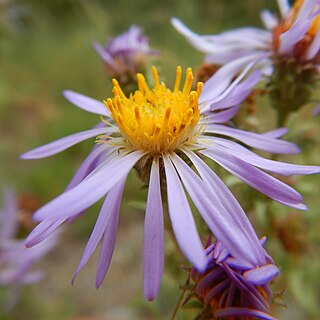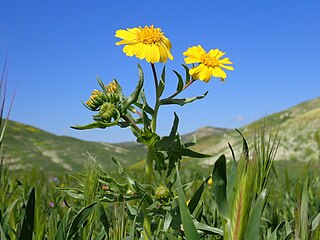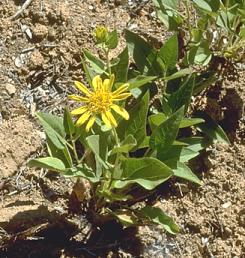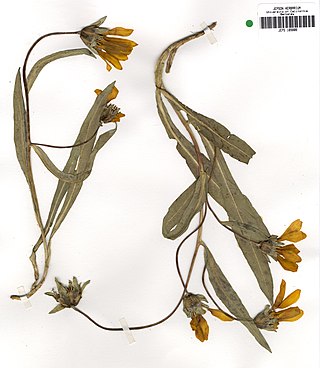
Symphyotrichum campestre is a species of flowering plant of the family Asteraceae commonly known as western meadow aster. It is native to much of western North America where it grows in many habitats, generally at some elevation.

Symphyotrichum frondosum is a species of flowering plant in the family Asteraceae native to western North America. Commonly known as short-rayed alkali aster, it is an annual or perennial herbaceous plant that may reach 140 centimeters tall.

Symphyotrichum greatae is a species of flowering plant in the family Asteraceae endemic to California and known by the common name Greata's aster.

Symphyotrichum lentum is a species of flowering plant in the family Asteraceae with the common name of Suisun Marsh aster. It is a perennial and herbaceous plant endemic to the marshes of Sacramento-San Joaquin River Delta of Northern California.

Erigeron chrysopsidis var. austiniae is a species of flowering plant in the family Asteraceae known by the common name sagebrush fleabane. It is sometimes considered a full species, Erigeron austiniae. It is native to the western United States from northeastern California to southwestern Idaho, where it grows in the sagebrush and juniper woodlands. It is a small, clumping perennial herb producing a hairy stem up to about 12 centimeters tall from a woody caudex and taproot surrounded by narrow linear to somewhat oval leaves up to 8 centimeters long. The inflorescence is a solitary flat-topped woolly flower head containing many yellow disc florets. There occasionally appears a yellow ray floret, but they are usually absent. The fruit is an achene with a pappus of bristles.

Erigeron multiceps is a species of flowering plant in the family Asteraceae known by the common names Kern River daisy and Kern River fleabane. It is endemic to California, where it is known mostly from the Kern Plateau in the southern High Sierra Nevada of eastern Tulare County. It is a perennial herb growing a hairy stem up to about 20 centimeters tall from a taproot and caudex. The base of the stem is surrounded by oblong leaves 2 to 5 centimeters long, and there are some smaller leaves along the length of the stem. The inflorescence produces hairy, glandular flower heads filled with yellow disc florets and a fringe of up to 125 thin, flat white to purple-tinged ray florets. The fruit is an achene with a pappus of bristles.

Hieracium argutum is a species of flowering plant in the family Asteraceae known by the common name southern hawkweed.
Madia anomala is a species of flowering plant in the family Asteraceae known by the common name plumpseeded madia. It is endemic to northern California, where it can be found on hillsides in the San Francisco Bay Area and adjacent mountains and valleys.

Madia gracilis is a species of flowering plant in the family Asteraceae known by the common names grassy tarweed, slender tarweed, and gumweed madia.

Madia radiata is a species of flowering plant in the family Asteraceae known by the common names golden madia and showy madia. It is endemic to California, where it is known mostly from the Central Coast Ranges and adjacent edges of the San Francisco Bay Area and Central Valley.

Madia sativa, known by the common names coast tarweed and Chilean tarweed, is a species of flowering plant in the family Asteraceae found in parts of western North and South America.

Agnorhiza bolanderi is a species of flowering plant known by the common name Bolander's mule's ears. It is endemic to California, where it is known only from a narrow section of the Sierra Nevada foothills about 275 kilometers long from Shasta County to Mariposa County. It grows in chaparral and grassland habitat, usually on serpentine soils.

Agnorhiza reticulata, known by the common name El Dorado County mule's ears, is a rare species of flowering plant found only in a small region of north-central California.

Agnorhiza elata is a species of flowering plants known by the common name Hall's mule's ears. It is endemic to California, where it is known only from a section of the central Sierra Nevada foothills. It occurs primarily in a region stretching from Tuolumne County to Fresno County, but a few isolated populations have been found in Tulare County.

Wyethia glabra is a species of flowering plant in the family Asteraceae known by the common name Coast Range mule's ears. It is endemic to California, where it grows in the North and Central Coast Ranges. It is a perennial herb growing from a tough taproot and caudex unit and producing a stem up to 40 centimeters tall. It is hairless to hairy and glandular. The leaves have lance-shaped or oval blades up to 45 centimeters long. The inflorescence is usually a solitary flower head or occasionally a cluster of 2 or more. The head has lance-shaped leaflike phyllaries at the base. It contains up to 21 yellow ray florets each up to 5 centimeters long and many yellow disc florets. The fruit is an achene over a centimeter long, including its pappus.

Wyethia longicaulis is a species of flowering plant in the family Asteraceae known by the common name Humboldt mule's ears. It is endemic to California, where it occurs in the North Coast Ranges and the Klamath Mountains. It grows in mountain and foothill habitat such as grassland and forests. It is a perennial herb growing from a tough taproot and caudex unit and producing a stem up to half a meter tall. It is hairless to hairy and glandular. The leaves have lance-shaped or oblong blades up to 20 centimeters long. They are glandular and have a waxy exudate that dries white. The inflorescence is usually a cluster of 2 to 4 flower heads, each with up to 10 yellow ray florets which may be up to 3 centimeters long. The fruit is an achene about a centimeter long, including its tiny pappus.

Agnorhiza ovata is a species of flowering plant known by the common name southern mule's ears. It is native to the mountains and foothills of southern California and Baja California, occurring the Coast Ranges and Sierra Nevada foothills in Tulare, Kern, Ventura, Los Angeles, Orange, Riverside, and San Diego counties in California, with additional populations in the Peninsular Ranges south of the international border.

Hymenothrix dissecta is a North American species of flowering plants in the family Asteraceae known by the common names yellow ragweed and ragleaf bahia. It is native to the western United States as far north as the Black Hills of South Dakota and Wyoming, as well as in northern Mexico.
Erigeron ovinus is a rare North American species of flowering plant in the family Asteraceae, called the sheep fleabane. It has been found only in the southeastern part of the US state of Nevada.

Symphyotrichum adnatum is a species of flowering plant in the family Asteraceae native to the southeastern United States and the Bahamas. It is a perennial, herbaceous plant that may reach 30 to 120 centimeters tall with flowers that have lavender ray florets and yellow disk florets. The common name scaleleaf aster has been used for this species.



















